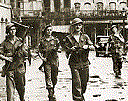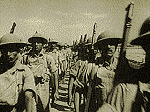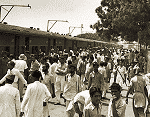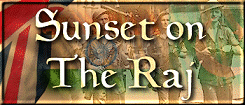Soldiers on the Side lines

Nothing could have prepared the British soldier for the death and suffering he was to witness in India during 1946 and 47. The riots in Calcutta in 1946 were stamped out by British and Indian troops but the rioting then spread to other cities. During the Calcutta riots, the main offenders were the Sikhs, who were aided by members of the local criminal fraternity, towards the Muslims. They killed and looted until the British Army came on the streets to restore order. In September Bombay went up in flames. By March 1947, when Rawalpindi also went up in flames, the death toll from communal rioting ran into tens of thousands. This rioting was not anti-British or anti-Government, but between Hindus and Sikhs on the one side and Muslims the other. By the time independence came in 1947 the rioting, death and destruction had reached its peak and the British soldier could only stand on the sidelines and witness the suffering of both Muslims and Hindus.

Indian ArmyThe Indian Army was the heart and soul of the old Indian Empire and now it had to be divided between the two national armies. Depots, tanks, guns, fuel, ammunition, forms and typewriters, uniforms, the regimental silver, sporting trophies- everything had to go. It says a great deal for the discipline of the old Indian Army and the goodwill that existed between the regiments, that this difficult and often emotional task, was carried out swiftly and with little fuss. Eventually the men and regiments had to be divided. The main division was fairly simple-Sikhs and Hindus to India, Muslim troops to Pakistan, but many regiments contained a mixture of religions and the situation was more complicated. Above all there was the question of what to do with the Gurkhas.
At this time Britain had her eyes on the famous fighting men from Nepal. There were 27 Gurkha Battalion's in the Indian Army, all of which the Indians wanted to retain, but eight battalions of Gurkhas, the 2nd, 6th, 7th and 10th Gurkha Rifles were transferred from the Indian to the British Army and all but one were shipped to Malaya . The other Gurkha battalions were transferred to the Indian Army where they remain today and still flourish. For some of the British Gurkha officers, the thought of being separated from their beloved Gurkhas was too much and many tears were shed before the British left India.

As a result of the partition, millions of people, Muslims and Hindus were forced to leave their homes. It is estimated that about five and a half million people were traveling in each direction. Muslims heading north to Pakistan , Hindus were heading south to the new India. Within days of the announcement of partition the Moslems, Sikhs and Hindus were attacking each other's refugee columns and trains, and massacring their former fellow citizens by the tens of thousands. The massacres were at their worst in the Punjab where trains were sent across the border into India filled with dead bodies. The carriages were marked'A present from Pakistan'and a train carrying dead Muslims in the other direction to Pakistan, was marked'Presents to Pakistan'. While this was going on , the British Army, with no role left to play and forbidden to interfere, stood by and watched the bitter fruits of independence.
Estimates vary but it is thought that about 2 million people lost their lives in the immediate aftermath of independence, especially during the migrations from India and Pakistan . One British officer of the 9th Gurkhas remembers having to rush his company to try and stop a huge massacre on a train in the Punjab. They arrived too late and found nothing but the mutilated corpses of men, women and children. Placing rocks on the line had halted a trainload of people, about 2000 in all. Then a horde of Sikhs, hiding in the nearby fields, had swarmed on to the train and slaughtered everyone on board.

In Lucknow, on the evening before independence, as soon as it got dark, a small party of British soldiers went quietly to the ruins of the British Residency in Lucknow, the place held by a small British garrison against all odds during the Indian mutiny 90 years before. To commemorate the famous stand, the ruined Residency was the one place in the British Empire where the Union Jack flew day and night and was not pulled down at sunset. Now that the Raj was over the British flag finally had to come down, but they would do this themselves. The flag was lowered but that was still not enough. The flagpole was dismantled and sawn off close to the ground and the hollow where it had stood for nearly 100 years was filled in with concrete. Next morning, Independence Day, a jubilant crowd of Indians arrived to haul down the Union Jack, but they found that it had already gone and all traces of where it had once flown completely vanished.



